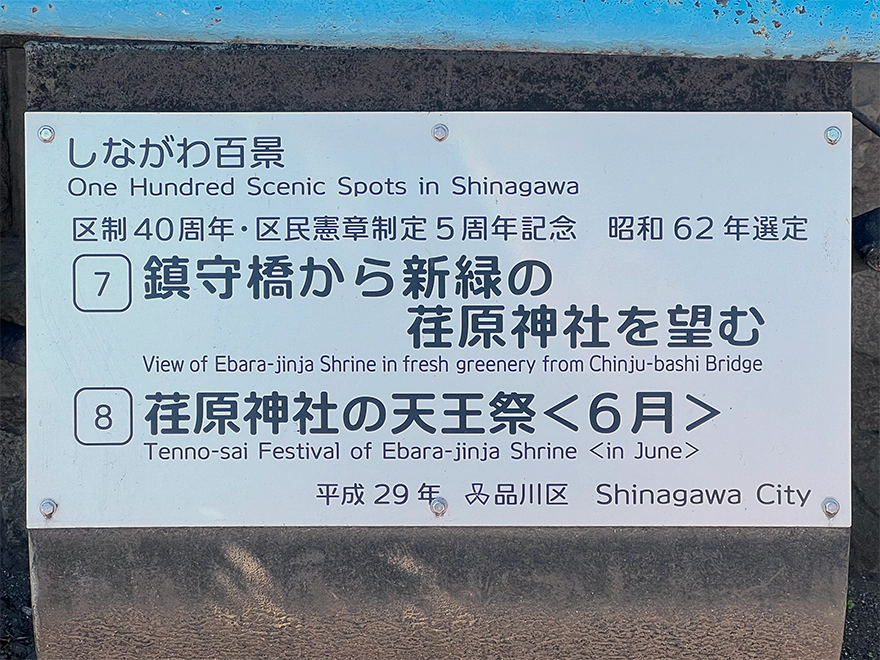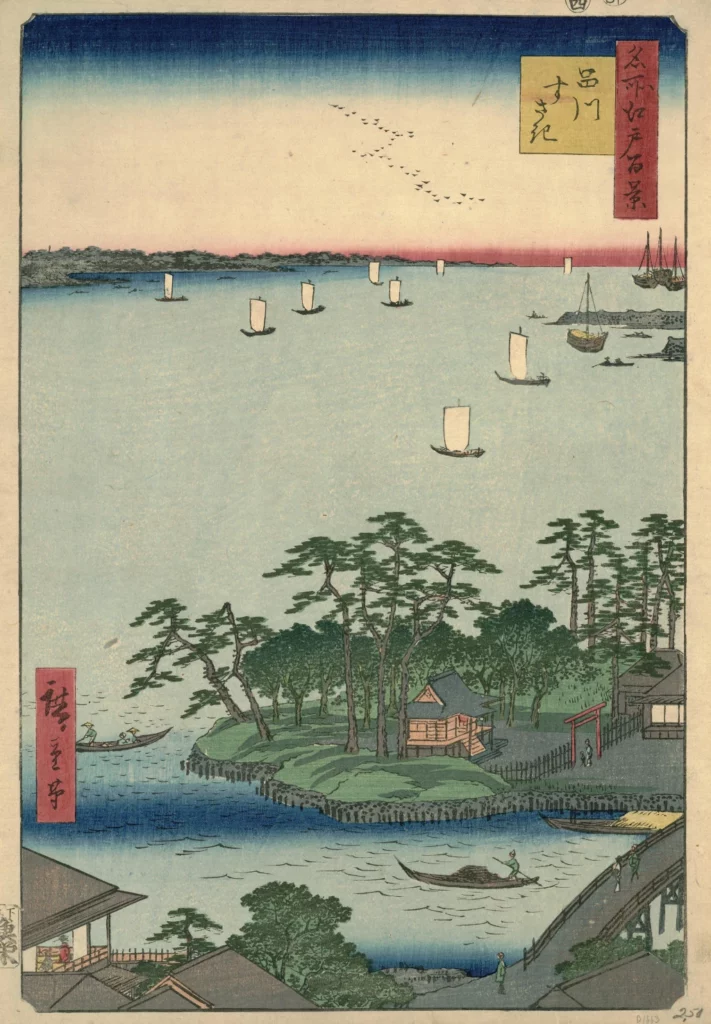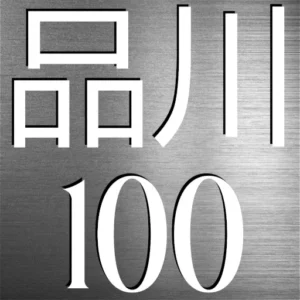What is the Tenno-sai Festival of Ebara-jinja Shrine?
An event in June, the Tenno-sai Festival (天王祭) at Ebara Shrine (荏原神社) is a traditional festival with a rich history featuring a divine mask.
The Divine Mask
Legend has it that during the Muromachi period, a spiritual dream led to the discovery of a divine mask of Gozu Tennō (Susanoo no Mikoto) that emitted a divine light on the sea not far from the coast. As a result the area became sacred and where fishing was prohibited. Modeled on the traditions of the Gion Festival in Kyoto a Shinto ritual of mikoshi washing began to be performed.
From this the area of the sea became known as Tennōzu. With the passage of time the area has changed. Land reclamation has occurred. Under the protection of the great god Ebara Okami it is now a place in Shinagawa where modern buildings stand.
Tenno-sai Festival (天王祭)
The Tenno-sai festival takes place annually in June. (Strictly speaking it is the Southern Tenno-sai, Minami no Tenno-sai to differentiate it from the Kita no no Tenno-sai at Shinagawa Shrine which does the northern one.) It is the shrine’s grand festival. The festival is associated with Ushitora-no-Okami, a deity believed to protect against epidemics.
One of the festival highlights is the unique tradition of carrying the mikoshi (portable shrine) wearing the divine mask into the sea. This ritual where the mikoshi is paraded into the water is called “Goshinmen Shinji Kaiju Gyoretsu”.
Since Gozu Tenno (Susanoo no Mikoto) is the god of water the participants are likened to Kappa (mythical water creatures) so the festival is commonly known as the Kappa Festival.
Festival Schedule (2024):
June 2 (Saturday): Grand festival ceremony at 2:00 PM.
June 3 (Sunday): Mikoshi procession to the riverbank at 9:00 AM.
June 4 (Monday): Mikoshi procession into the sea at Odaiba Kaihin Koen (Odaiba Seaside Park) at 10:00 AM. i.e miles away and not in Shinagawa. It’s at Odaiba.
🌀 Shrine Details
- Enshrined Deity: Takeminakata-no-Mikoto (建御名方命) — god of water, wind, and fishing
- Affiliation: Shinto – Independent
- Founded: 709 CE (traditionally)
- Annual Events: Tenno-sai (June), Shichifukujin Pilgrimage, Spring Festival
This festival reflects both the local maritime roots of Shinagawa and the broader Shinto connection to natural purification — particularly by water.
📍 Visitor Information
Address: 2-30-28 Kitashinagawa, Shinagawa-ku, Tokyo 140-0001
Best time to visit: Early June (festival usually the first Sunday)
Admission: Free
Where is it?
| what3words | ///shopping.downward.petted |
| latitude longitude | 35.6179177 139.7379243 |
| Nearest station(s) | Shinbanba Station (Keikyū Main Line) Kitashinagawa Station (Keikyū Line) |
| Nearest public conveniences | Cross the river south, then go east and they’re just by Shinshinagawa Bridge. |
Show me a sign.

A double sign that shows little sign of weathering.
Withervee says…
Most festivals stay on dry land. This one wades into the ocean. It’s dramatic, soaked in myth, and weirdly moving. If you’re nearby when the mikoshi goes in, watch closely — then back away unless you want your socks blessed.
I’ve found a few terms associated with the Tenno-Sai festival
“Goshinmen Shinji Kaiju Gyoretsu” is a Japanese phrase that can be broken down into four parts:
“Goshinmen” (御神面) translates to “divine mask” or “sacred mask”.
“Shinji” (神事) refers to “Shinto ritual” or “religious ceremony”.
“Kaiju” (海中) means “in the sea” or “underwater”.
“Gyoretsu” (行列) refers to “procession” or “parade”.
So this could be translated as “the procession of the divine mask in the sea during a Shinto ritual”
“Goshinmen Kaichū Togyo” can be broken down into three parts:
“御神面” (Goshinmen) again translates to “divine mask” or “sacred mask”.
“海中” (Kaichū) means “in the sea” or “underwater”.
“渡御” (Togyo) refers to a procession of a deity, often in the form of a mikoshi (portable shrine) during a festival.
Goshinmen Mikoshi Kaichū Togyo This phrase can be broken down into four parts:
“Goshinmen” (御神面) translates to “divine mask” or “sacred mask”.
“Mikoshi” (神輿) refers to a “portable shrine” used in Shinto processions.
“Kaichū” (海中) means “in the sea”
“Togyo” (渡御) refers to a procession
I think this occurs on the final day of the festival.
Additionally, every year, Ebara Shrine holds the Kibune Festival in September which is the founding ceremony and the Otori Festival in November.
Otori Festival
Another deity enshrined here is Yamato Takeru no Mikoto1, whose father was the 12th Emperor Keikō. A legendary hero worshipped by many as the ancestor of the development of the country. It is said that after death his soul turned into a great white bird and flew away. Hence Otori (great bird).
The Otori Festival began during the Niiname-sai festival (November), It is said to have begun as a combination of the birth of the town, the prosperity of commerce and industry and the faith of merchants in connection with the festival of the new harvest and the festival of thanksgiving. In the Edo period, it attracted many believers from merchants and people in the water business. In the past, it attracted the faith of samurai as a god of long-lasting military fortune, and also the faith of farmers praying for a good harvest.
Before it was reclaimed, Tennozu was an islet formed by the accumulation of sediment in the sea.
Mask Origin Stories
The legend recalled in the Divine Mask section above is according to Ebara Shrine. And, according to which sources you read, the mask was found in a fisherman’s net and pulled from the sea in this area around 1751.
A folktale
However, according to other sources it wasn’t found quite so close to Shinagawa. A folktale says: In the first half of the Edo period, a villager from Banshomen (present-day Misato City, Saitama Prefecture) was passing by Suzaki 2in a boat when he found a shining object floating gently on the waves. “Oh, what could that be?” Curious, he hurried over in his boat and picked up the shining object from the sea, which turned out to be a golden mask that looked very similar to that of Gozu Tenno (Susanoo no Mikoto). The villager exclaimed, “This is a beautiful golden mask, it may be a precious object,” and after consulting with the people of Ryōshi-machi, he donated it to Kibune Shrine (present-day Ebara Shrine). One night, a god appeared in the dream of the chief priest of Kibune Shrine and told him, “That golden mask was picked up from the sea, so please let it cross the sea once a year,” before disappearing. When the priest woke up, he thought, “This must be a message from God,” so he gathered fishermen from Shinagawa, attached masks to the roof of the portable shrine, and carried it through the sea to the accompaniment of spirited music, chanting, “It’s Tenno! It’s the portable shrine! Wasshoi! Wasshoi! Moume! Moume!” And what happened? That year, there were almost no water accidents, and there was a large catch of seaweed, fish, and shellfish.
History Says…
According to the Shinagawa Ward Board of Education’s “History of Shinagawa” the man who found it wasn’t a fisherman. In 1751 a farmer from Banshomen Village, Katsushika County, Nigohan-ryo (present-day Banshomen, Misato City, Saitama Prefecture) discovered something shiny in the sea on his way back from carrying vegetables to Shinagawa. He picked up the divine mask and brought it home, but he started having nightmares, so he dedicated the mask to Yoriki Shrine and offered some rice as a sacred offering. The divine mask was later moved to Kibune Shrine (Ebara Shrine), where the priest was located. It is understood that the origin of the procession was believed to be that bathing the mask in seawater once a year would ensure good crops and seaweed harvests, and a large catch in the fishing industry. It is also said that the area where the sacred mask was picked up was named Tennozu because it was an island.
- There are a couple of movies featuring his adventures. “Nippon tanjo” aka “The Birth of Japan”. “The Three Treasures” is an edited down version for international distribution. And “Yamato Takeru” as a movie and anime TV Series ↩︎
- Shinagawa’s “Susaki” is a sandbank formed by the accumulated soil at the mouth of the Meguro River, and was originally an uninhabited land called “Kabutojima”. It was depicted in “One Hundred Famous Views of Edo: Susaki Shinagawa” painted by Utagawa Hiroshige in 1856.
(Confusingly, Susaki is also the former name of Toyo 1-chome , Koto Ward , Tokyo. It was a town build on land reclaimed during the Genroku period (1688-1704) and was formerly known as “Fukagawa Susaki Jyuman Tsubo” (100,000 square meters), It was a scenic spot overlooking the sea. In 1791 a typhoon caused a storm surge in the Susaki area. It engulfed houses and caused great disaster with many fatalities. Following this the shogunate banned the construction of houses in the Susaki area in case for further storm surges) ↩︎

The “shrine” depicted in the centre of the picture is “Susaki Benten-do (Hall)”, and in front of it is the mouth of the “Meguro River”, with the “Chokai Bridge” stretching from “Kitashinagawa-juku” in the foreground. In 1655, the first year of the Meireki era, residents of ‘Minami-Shinagawa-juku’ who refused the post’s horse duty were forcibly relocated there, leading to the birth of the fishing town ‘Minami-Shinagawa Ryōshi Machi’. This became known as Shinagawa-Ura
!– wp:heading {“level”:4} –>
Site Character
- Lifestyle 生活 (Seikatsu): ✔️
- Historical Significance 歴史 (Rekishi): ✔️
- Atmosphere/Natural Features 風土 (Fūdo): ✔️
Who in their right mind would vote for this?
- Local (Shinto) believers
- Water ritual fans
- Festival chasers
- History reenactors
- Salt-splashed photographers
Further reading
Festivals at Ebara-jinja – official site (Japanese)

